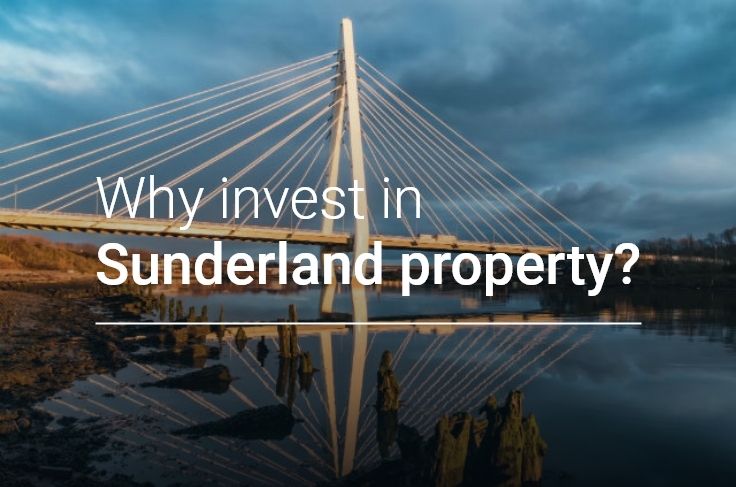Why Invest in Sunderland Property?

Like many cities in Northern England the northeastern maritime city of Sunderland was once a giant of manufacturing. With times and technologies changing, these entire regions have tended to fall by the wayside, certainly when compared to London and the South East. However, there are strategic drives from government at both a national and local level to redress the balance through long term investment and major changes to infrastructure.
In effect, what this means is that now is a very good time to invest in these once neglected areas as they are due an uplift in prosperity, growth and population. Sunderland is a good example of a city with exceptionally low house prices and great potential – not to mention strong yields.
Below, we go into more detail on why investors should be looking to Sunderland.

Why Invest in Sunderland in 2019? Aspen Woolf
Invest in Sunderland: Regeneration, Investment and Growth
The 3,6,9 Vision is a major strategy to help bring Sunderland in line with the Northern Powerhouse initiative by investing £1.5bn into the city across a number of sites. This investment will bolster Sunderland’s economic growth by contributing to the creation of 20,000 new jobs.
Sunderland has a strong history in the manufacturing and automotive sectors, and it is understood that these ought to continue to play a big part in the city’s GVA. 5,000 of those new jobs will be dedicated to manufacturing through the creation of the International Advanced Manufacturing Park and its associated Enterprise Zone – set to become one of foremost development in Europe’s manufacturing and automotive trades. The IAMP will help generate around over £400 million of private sector investment through circa 371,000sqm of manufacturing space.
Any city wanting to compete in the 21st century must make a commitment to nurturing digital infrastructure. Sunderland is showing its willingness to adapt to the 21st century by aiming to create 2,000 jobs in the Software Industry and 1,500 in the Social Enterprise Sector. The Vaux site will make a large contribution to these areas through a 5.5 hectare landmark development in the former Vaux Brewery. Said to be the most significant of the city centre developments, Vaux will bring around 2,500 jobs in its own right, and will provide a combination of office space, shops, restaurants, cafes, a hotel, and apartments.
The city centre has already seen investment in the high-street, via a £2 million plan to improve two streets and the public square. The Minster Quarter Masterplan proposes a further £3 million of spending to upgrade the city centre and mark it out as a cultural destination.
According to the 3,6,9 Vision, total infrastructure developments should create an additional GVA of £1.8bn by from 2015-2024. On the issue of economy, it’s worth highlighting some current success stories.
Last year saw the opening of the stunning Northern Spire Bridge, the tallest structure in the North East. 2,000 people worked on the 340m long construction that joins the banks of the River Wear, and is estimated to help create over 6,000 jobs – as well as work as a significant piece of branding, signaling the industriousness of Sunderland.
In June of this year the 10 millionth vehicle was constructed at Nissan’s Sunderland plant. The 10 million mark has been reached after 33 years of production, which makes Sunderland’s Nissan plant the fastest producing automobile manufacturer in the UK. Over that time Nissan has grown from 470 to around 7,000. Only a year earlier the 1 millionth Nissan Juke was built in Sunderland. These figures are quite staggering, and it’s a testament to Sunderland’s ingenuity.
Two companies have announced notable news for the city over the last few months – Hyperdrive Innovation and Ocado. Granted you might not have heard of the former, a lithium battery manufacturer, but it’s precisely these kind of components that Sunderland is accustomed to building. Hyperdrive Innovation have doubled the size of its production facility after a £350,000 investment. Remember the Veux site mentioned earlier? Ocado are named as the first occupier of the The Beam building, taking the top two floors and creating 300 jobs.
Hopefully this paints a positive picture of Sunderland’s output, but to make it even clearer, the Department for International Trade show that in 2018/19 the North East created 125 jobs for every 100,000 people of working age population. That places the region behind only London and the West Midlands as the best performing UK areas.

Why Invest in Sunderland? Attractive Prices and High Yields
Invest in Sunderland: Low Prices, High Demand and High Potential
Now is an excellent time to invest in Sunderland. While house prices in several northern cities have seen a dip over the last few months (up to September 2019), Sunderland has in fact enjoyed a significant rise of 2.9% – 1.5% more than the national average. The city still remains one of the cheapest places to buy property. According to the Land Registry, Sunderland’s average house price at £118,648 is an enormous £114,062 below the average house value for the UK.
While house prices are cheap, rental yields are exceptional, especially in the most central SR1 postcode that generates an impressive 7.53% average yield. As a comparison, that is 2.72% more than London’s top BTL postcode. The private rental sector is the fasted growing sector and has doubled in the last 10 years.
The future looks even brighter for Sunderland property investors as the demand for housing is due to outweigh the supply – 14,000 new homes are required by 2033 to bring the city in line with its economic targets as outlined in the 3,6,9 Vision.

Why Invest in Sunderland? Good Student Rental Market
Invest in Sunderland: Student Rental Demand
A hugely important factor in the local rental economy is the demand among students; there are over 19,000 students at the University of Sunderland, and over 3000 of those graduate each year. Sunderland’s university is forging international connections around the world, with a new campus in Hong Kong and numerous learning institutions across the world.
The university’s presence in Sunderland itself has been growing thanks to several large scale investments, including an entirely new medical school and an Hope Street Xchange, the University of Sunderland’s £10m centre for enterprise and innovation.
The University of Sunderland is becoming ever more popular and that means more demand for student rentals.
Sunderland’s Overall Outlook for Property Investors
When people think of Northern England it’s most likely that Yorkshire or north-western cities like Manchester or Liverpool come to mind. Given the North East’s strong performance in property value and rental yields, cities like Sunderland should not be overlooked and represent a new focal point for investors looking for extraordinarily low prices.
Aspen Woolf are experts in property investment, with over 14 years of experience generating high performing income streams for our investors.
Have a look at our investment opportunities


